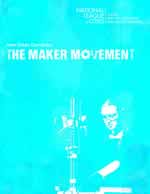 A new National League of Cities (NLC) report, “How Cities Can Grow the Maker Movement,” is a first-of-its-type analysis on the emergence of new urban manufacturing and technology enterprises, highlighting examples from Boston Harbor to the San Francisco Bay, and analyzing what role local policy can play in the movement’s success.
A new National League of Cities (NLC) report, “How Cities Can Grow the Maker Movement,” is a first-of-its-type analysis on the emergence of new urban manufacturing and technology enterprises, highlighting examples from Boston Harbor to the San Francisco Bay, and analyzing what role local policy can play in the movement’s success.
“Only 26 percent of American cities are engaging in the maker movement, which is shown to have a positive economic impact in cities,” says NLC CEO Clarence Anthony. “Across the country, cities are working hand-in-hand with maker communities to invest in makerspaces and encourage entrepreneurialism. City-level support has helped to cement the role of makers as potential job creators and conduits for economic growth.”
“Cities can incentivize economic growth and entrepreneurism,” adds NLC Center for City Solutions Director Brooks Rainwater. “This report provides cities with tangible ways to innovate and take advantage of the ever-growing sharing economy. Cities that have designated spaces for prototyping, manufacturing, innovation and collaboration have seen economic growth and more competitive workforces.”
“How Cities Can Grow the Maker Movement” explores small production and related maker activities in Philadelphia, San Francisco plus mid-tier cities Albuquerque, N.M.; Austin, Texas; Boulder, Colo.; Burlington, Vt.; Chattanooga, Tenn.; Eugene, Ore.; Louisville, Ky.; and Madison, Wis. The maker movement has developed in a variety of different environments, including “maker spaces,” fabrication laboratories and tech workshops. Data behind the report was derived from interviews with influential points of contact in cities where the movement is growing. Survey questions focused on four primary sections: characteristics, growth, government policies and challenges.
Report authors provide insights into common trends and notable differences examined in each. The characteristics section focuses on the driving forces behind the movement and people involved. The section on growth or commercialization aims to establish the scale of involvement in order to determine whether the movement has the potential to increase local U.S. manufacturing. The policies section details local governments’ role in growing or inhibiting the movement, researchers especially keen on the most beneficial policies. Ultimately the goal was to determine how other local governments could implement policies with a proven record of success in their respective cities.
The report augments understanding of the maker movement, which can include everything from small production manufacturing to prototyping. Many cities that have invested in maker spaces—prioritizing such basics as high-speed connectivity—have seen a positive economic return and attracted capital, talent and industry, NLC contends.
The National League of Cities prepared the report to inform local government leaders on becoming engaged in and benefitting from the maker movement, and has posted the document for download at www.nlc.org.
